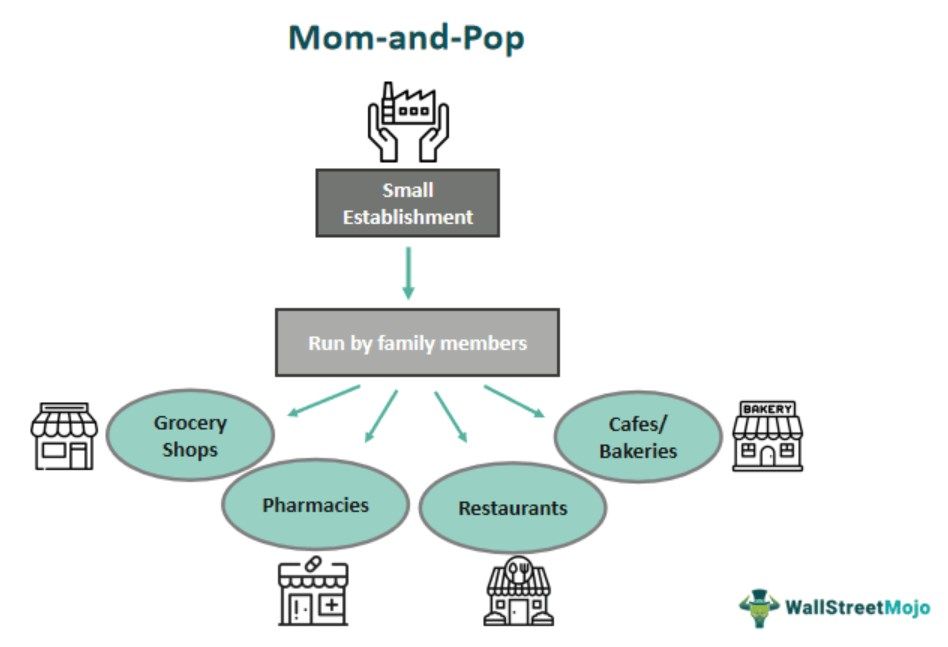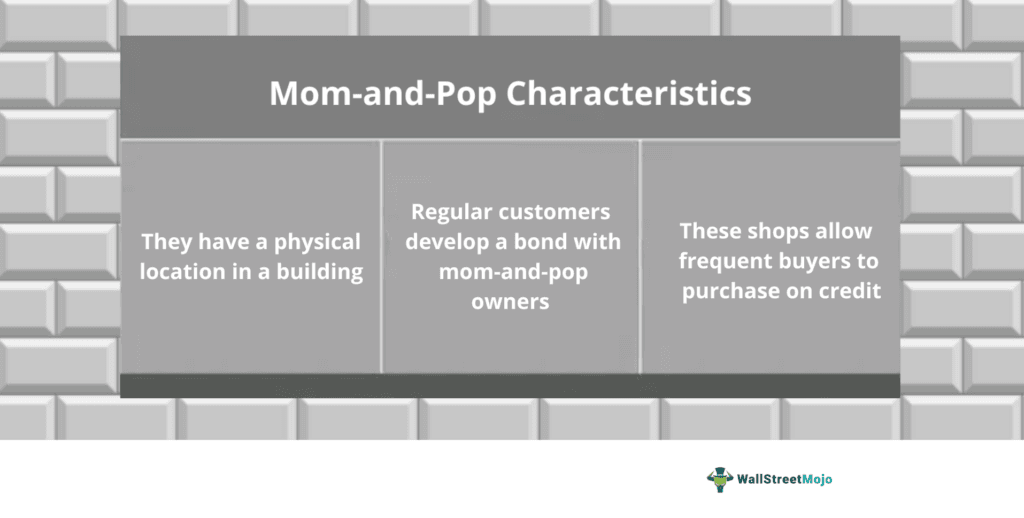Table Of Contents
Mom-and-Pop Meaning
Mom-and-Pop is a popular informal phrase that refers to a small independent firm run by family members. These businesses are usually brick-and-mortar establishments. Family-owned retail outlets include grocery shops, bookshops, restaurants, cafes, bakeries, pharmacies, and automotive repair shops.

These stores can be started with limited capital investment—aggregated by family members from savings and borrowings. These businesses target local customers. They are popular and recognized as the neighbourhood store that offers utility goods and services.
Key Takeaways
- Mom-and-Pop is an informal term given to small independent retail shops owned and run by a single family.
- Post-1978, big-chain retailers have taken the market by storm—many small family-owned outlets have shut down in the US.
- Unlike franchises, chains, and malls, small businesses enable direct interaction with consumers. These stores do not require a huge stock; they don’t need to offer a variety of products.
Mom-and-Pop Explained
Mom-and-Pop shops are small retail outlets run by a husband and a wife, a brother and a sister, or a father and a son—it’s the nearby family store. These mom-and-pop stores are brick-and-mortar stores and not franchises. These shops attract buyers or customers from the vicinity.

As a business model, these shops differ from large multinational companies—they require little investment capital, fewer employees, and enable direct interaction with consumers. Moreover, unlike malls, these shops need not maintain huge stock or provide a variety of products. Also, such outlets are often registered as a sole proprietorship, a partnership, an S corporation, or a limited liability company.
For individuals who plan to open up a small business, mom-and-pop shops are a great option—especially for those having family support. Aspiring shops owners can follow the following steps to start their venture:
- Find a unique and pragmatic business idea that solves a problem. Ideally, the idea should fulfill the requirements of the main target—the local and nearby customers.
- Further research about the mom-and-pop stores and business idea, product selection, and target market.
- Analyze the financial requirement, available capital, and required skill set for the particular business.
- Owners who don’t have a brick-and-mortar setup can rent one. Aspiring owners should next arrange resources, make an investment, and start the business.
- Finally, promote the new venture via word of mouth, social media, and local advertisements.
Despite tough competition from big chains like Walmart, Amazon, and Kroger Co, mom-and-pop shops provide high consumer satisfaction and customer service—owing to personalized consumer interaction. Since owners themselves operate the stores, they can personally guide the customers in selecting suitable products. These convenience shops facilitate access to necessary goods and services for the people residing nearby.
Moreover, locals often approach these store owners to sponsor community programs, sports events, donations, and charity. In the US, March 29 is celebrated as the National Mom and Pop Business Owners’ Day—acknowledging the 27 million small businesses operating within the country.
Mom-and-Pop Investors
The term ‘Mom-and-Pop’ can also refer to amateur investors. These individuals pool small amounts and sometimes even invest all their savings in the stock market—leaving it to destiny.
They are often optimistic about making a huge return on their investment. Some amateur investors even rely on brokers and online trading platforms. However, a lack of proper market knowledge and market research usually results in losses.
Examples
Let us understand the concept of mom-and-pop businesses with the help of some suitable examples.
Let us assume that Brian needs a haircut. His best option is to approach the nearby salon where owners are skilled and can provide personalized styling solutions. Similarly, if Brian runs out of salt while preparing lunch, he can immediately run to the next-door grocery shop.
Now, let us discuss some real-world examples that started as small businesses and went on to become global brands.
Starbucks
The renowned retail chain of coffee shops initially started in 1971 as a small, cozy café. The first Starbucks opened in Pike Place Market, Seattle. It soon became locally famous for freshly brewed whole-bean coffee.
In 1982, one of Starbucks' loyal consumers joined as a director of marketing and retail operations; Howard Schultz supplied coffee to the local espresso bars and restaurants. Later, he opened a retail chain of coffee shops named Giornale, which acquired Starbucks Corp. in 1987. Right after its acquisition, Starbucks operated 17 stores; later, the number escalated to 30,000 outlets worldwide.
Whole Foods Market
‘Whole Foods Market’ is the largest grocery chain in the world. But it all started as a small natural foods store—Safer Way. It was an initiative by John Mackey and Renee Lawson. In 1978, they opened a store in Austin, Texas.
The couple borrowed a sum of $45000 from their relatives and friends. The business became a huge success after merging with a partnership firm—Clarksville Natural Grocery. The partnership firm was run by Mark Skiles and Craig Weller.
The trajectory is similar to Walmart. Walmart, too, started as a mom & pop store—it was started by Sam Walton and his family in 1950.
How Do Mom-and-Pop Stores Stay In Business?
Just as any other forms of business has its own benefits and limitations, so does this type of mom-and-pop shops. It has its own setoff competitors, external and internal problems and solution as well as innovative opportunities for expansion and growth. It is necessary to be able to identify the correct time and idea that can be used by these businesses to survive.
- The main requirement for their survival is good relation and communication with the local people. They need to connect greatly with the local market, understand their needs, taste, preferences and cater to the same on time. They need to customize their services so that even though there are big players in the market with same products and services, people think about these mom-and-pop stores first to buy them. This does not happen in one day, but takes year to make it to that level.
- They also need to concentrate on great customer services so that clients have a unique experience when they enter their shops and feel very comfortable and valuable.
- Mom-and-pop landlords should have a curated selection of goods that not only meet user expectations, but also make them buy it even though they do not actually require it.
- These forms of business usually try to identify those areas of a product which are not available with big players mainly due to the fact that the customer base for such products and services are very low. But even such less customer prove to be valuable for mom-and-pop stores because such customers usually remain loyal for a long time due to unavailability of those unique products with big companies.
- The specialty in their product range is typically what differentiates them from other competitors.
- The mom-and-pop businesses often concentrate on providing environment friendly goods and services which is gaining importance by leaps and bounds in the current environment-conscious world.
- However, even though the business is small, it is important that mom-and-pop landlords adopt new technologies and production methods, keep track of changing market trends and embrace digital tools and social media.
